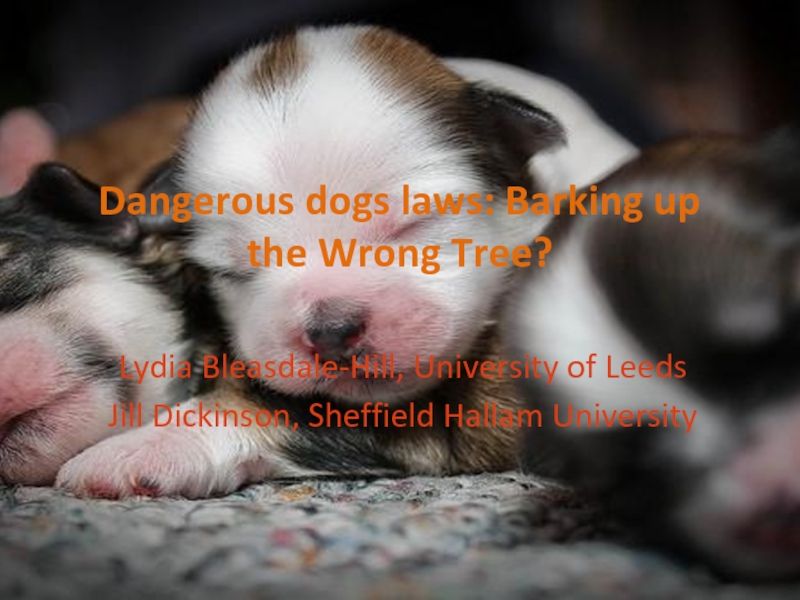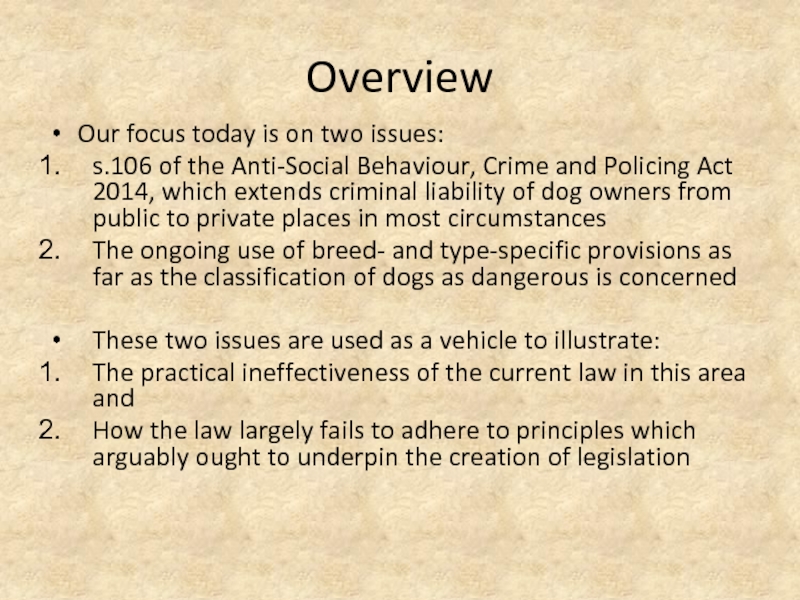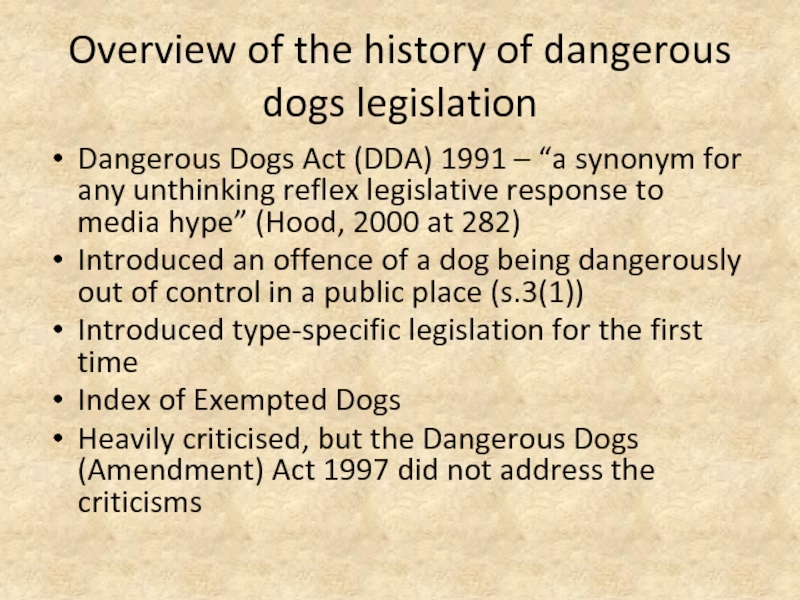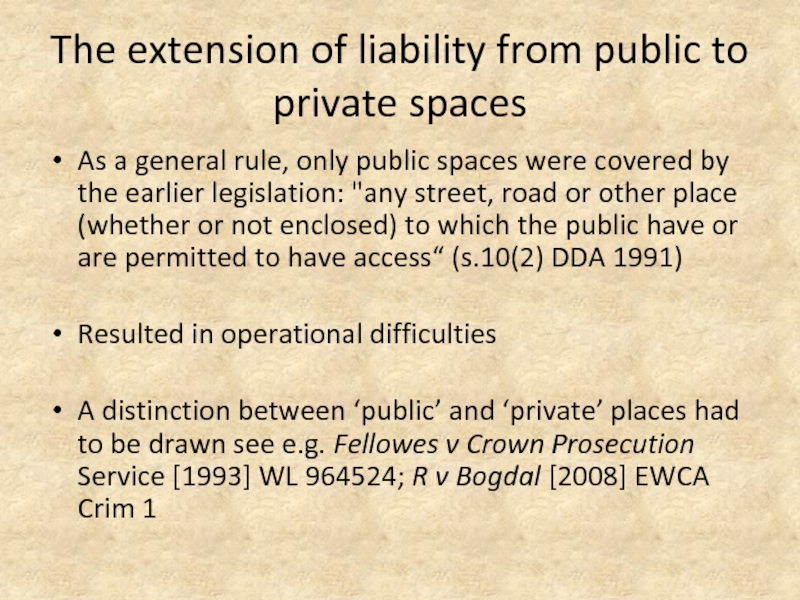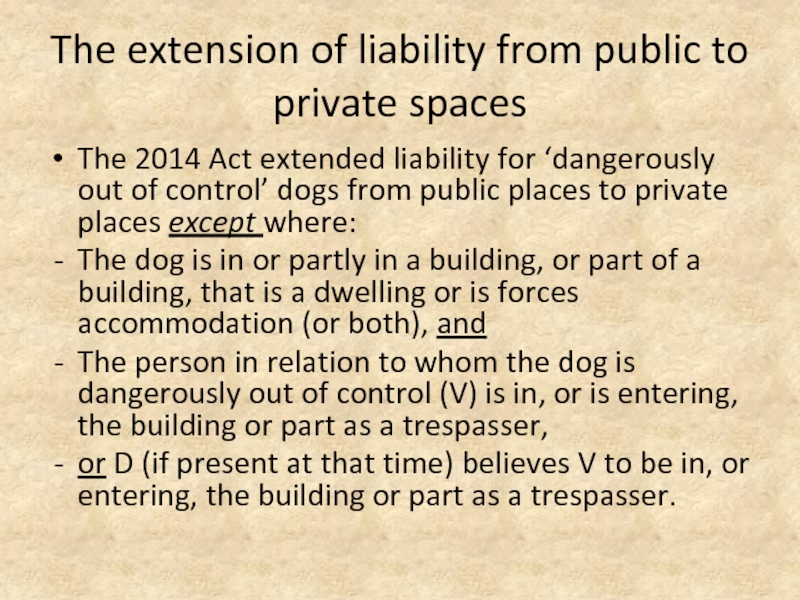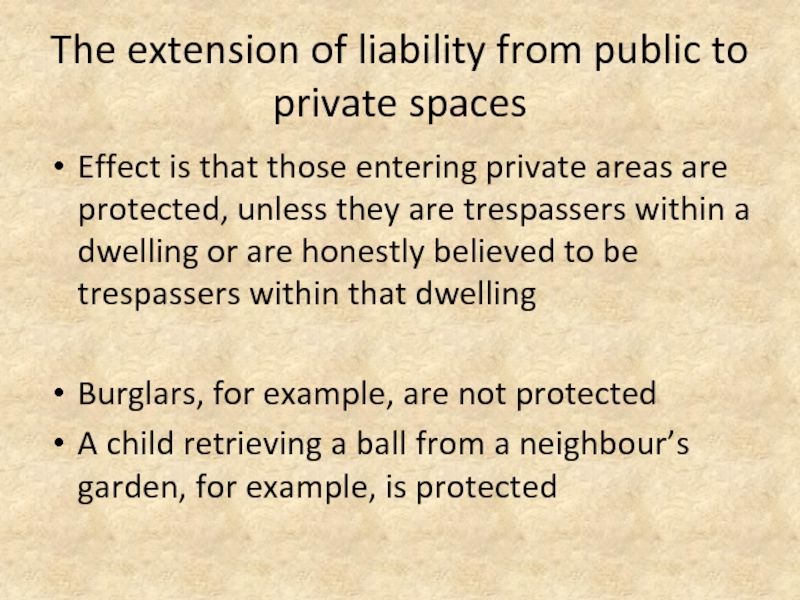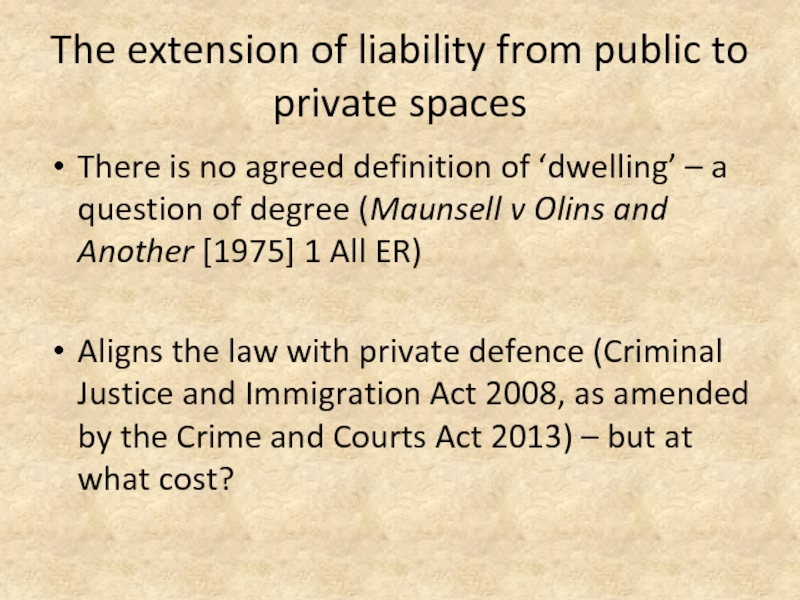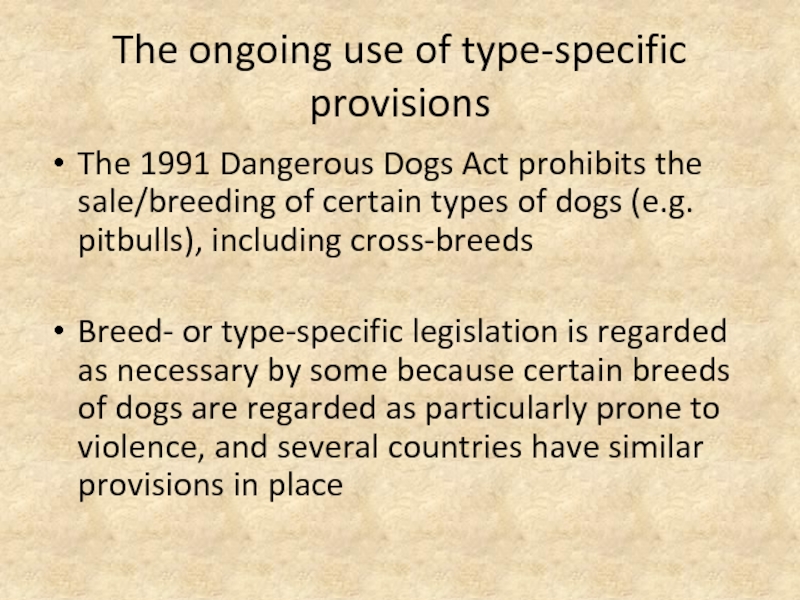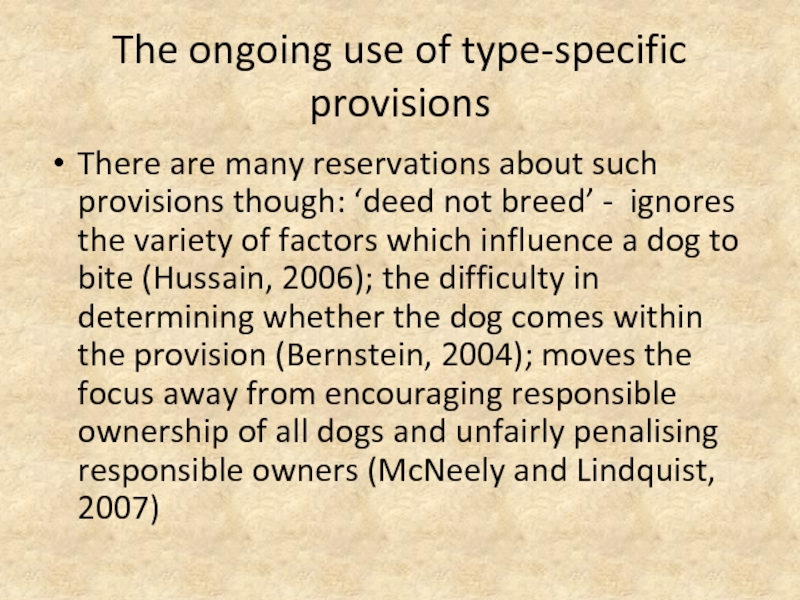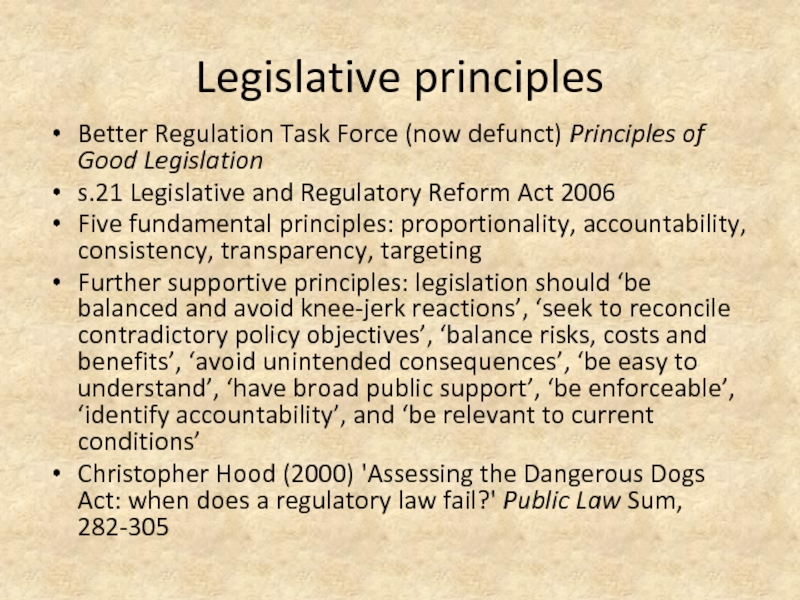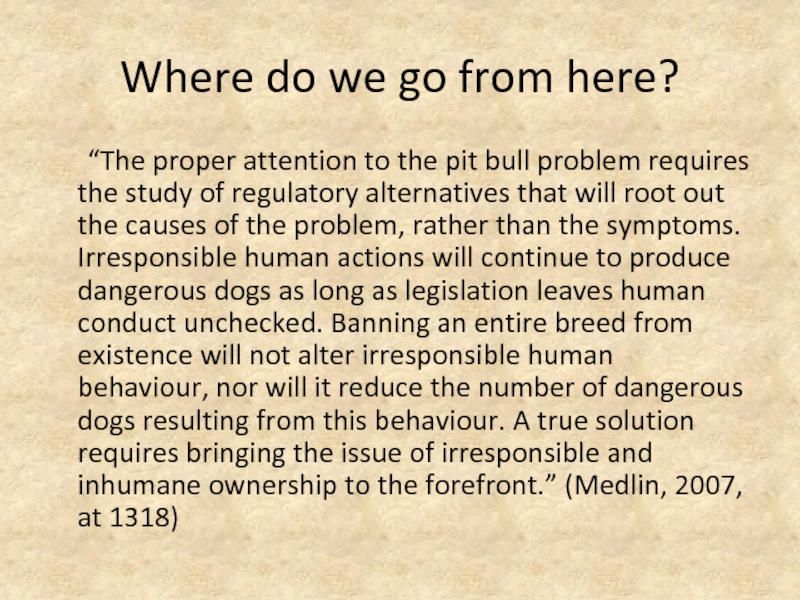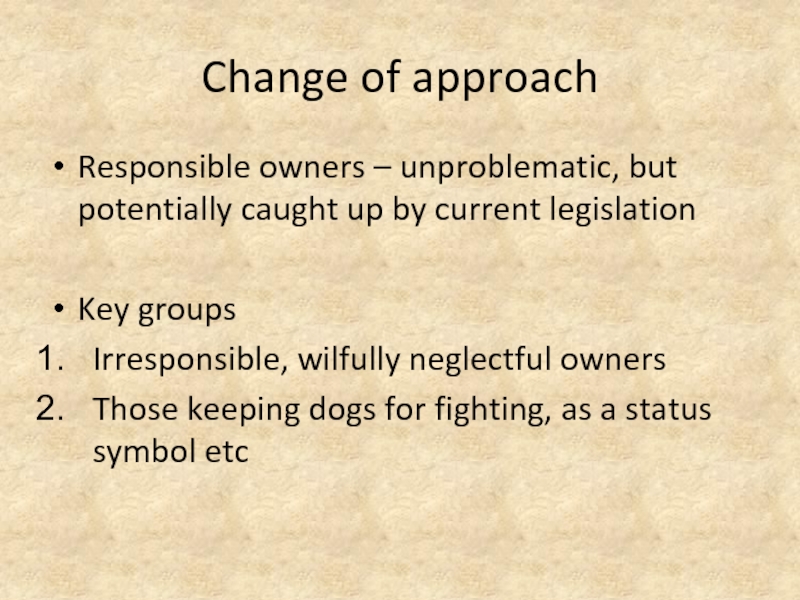Leeds
Jill Dickinson, Sheffield Hallam University
- Главная
- Разное
- Дизайн
- Бизнес и предпринимательство
- Аналитика
- Образование
- Развлечения
- Красота и здоровье
- Финансы
- Государство
- Путешествия
- Спорт
- Недвижимость
- Армия
- Графика
- Культурология
- Еда и кулинария
- Лингвистика
- Английский язык
- Астрономия
- Алгебра
- Биология
- География
- Детские презентации
- Информатика
- История
- Литература
- Маркетинг
- Математика
- Медицина
- Менеджмент
- Музыка
- МХК
- Немецкий язык
- ОБЖ
- Обществознание
- Окружающий мир
- Педагогика
- Русский язык
- Технология
- Физика
- Философия
- Химия
- Шаблоны, картинки для презентаций
- Экология
- Экономика
- Юриспруденция
Dangerous dogs laws: Barking up the Wrong Tree? презентация
Содержание
- 1. Dangerous dogs laws: Barking up the Wrong Tree?
- 2. Overview Our focus today is on two
- 3. Overview of the history of dangerous dogs
- 4. The extension of liability from public to
- 5. The extension of liability from public to
- 6. The extension of liability from public to
- 7. The extension of liability from public to
- 8. The ongoing use of type-specific provisions
- 9. The ongoing use of type-specific provisions
- 10. Legislative principles Better Regulation Task Force (now
- 11. Selected focus Transparency Consistency Balance risks, costs and benefits
- 12. Where do we go from here?
- 13. Change of approach Responsible owners –
- 14. Contact details Jill Dickinson: E: Jill.Dickinson@shu.ac.uk
Слайд 2Overview
Our focus today is on two issues:
s.106 of the Anti-Social Behaviour,
Crime and Policing Act 2014, which extends criminal liability of dog owners from public to private places in most circumstances
The ongoing use of breed- and type-specific provisions as far as the classification of dogs as dangerous is concerned
These two issues are used as a vehicle to illustrate:
The practical ineffectiveness of the current law in this area and
How the law largely fails to adhere to principles which arguably ought to underpin the creation of legislation
The ongoing use of breed- and type-specific provisions as far as the classification of dogs as dangerous is concerned
These two issues are used as a vehicle to illustrate:
The practical ineffectiveness of the current law in this area and
How the law largely fails to adhere to principles which arguably ought to underpin the creation of legislation
Слайд 3Overview of the history of dangerous dogs legislation
Dangerous Dogs Act
(DDA) 1991 – “a synonym for any unthinking reflex legislative response to media hype” (Hood, 2000 at 282)
Introduced an offence of a dog being dangerously out of control in a public place (s.3(1))
Introduced type-specific legislation for the first time
Index of Exempted Dogs
Heavily criticised, but the Dangerous Dogs (Amendment) Act 1997 did not address the criticisms
Introduced an offence of a dog being dangerously out of control in a public place (s.3(1))
Introduced type-specific legislation for the first time
Index of Exempted Dogs
Heavily criticised, but the Dangerous Dogs (Amendment) Act 1997 did not address the criticisms
Слайд 4The extension of liability from public to private spaces
As a general
rule, only public spaces were covered by the earlier legislation: "any street, road or other place (whether or not enclosed) to which the public have or are permitted to have access“ (s.10(2) DDA 1991)
Resulted in operational difficulties
A distinction between ‘public’ and ‘private’ places had to be drawn see e.g. Fellowes v Crown Prosecution Service [1993] WL 964524; R v Bogdal [2008] EWCA Crim 1
Resulted in operational difficulties
A distinction between ‘public’ and ‘private’ places had to be drawn see e.g. Fellowes v Crown Prosecution Service [1993] WL 964524; R v Bogdal [2008] EWCA Crim 1
Слайд 5The extension of liability from public to private spaces
The 2014 Act
extended liability for ‘dangerously out of control’ dogs from public places to private places except where:
The dog is in or partly in a building, or part of a building, that is a dwelling or is forces accommodation (or both), and
The person in relation to whom the dog is dangerously out of control (V) is in, or is entering, the building or part as a trespasser,
or D (if present at that time) believes V to be in, or entering, the building or part as a trespasser.
The dog is in or partly in a building, or part of a building, that is a dwelling or is forces accommodation (or both), and
The person in relation to whom the dog is dangerously out of control (V) is in, or is entering, the building or part as a trespasser,
or D (if present at that time) believes V to be in, or entering, the building or part as a trespasser.
Слайд 6The extension of liability from public to private spaces
Effect is that
those entering private areas are protected, unless they are trespassers within a dwelling or are honestly believed to be trespassers within that dwelling
Burglars, for example, are not protected
A child retrieving a ball from a neighbour’s garden, for example, is protected
Burglars, for example, are not protected
A child retrieving a ball from a neighbour’s garden, for example, is protected
Слайд 7The extension of liability from public to private spaces
There is no
agreed definition of ‘dwelling’ – a question of degree (Maunsell v Olins and Another [1975] 1 All ER)
Aligns the law with private defence (Criminal Justice and Immigration Act 2008, as amended by the Crime and Courts Act 2013) – but at what cost?
Aligns the law with private defence (Criminal Justice and Immigration Act 2008, as amended by the Crime and Courts Act 2013) – but at what cost?
Слайд 8The ongoing use of type-specific provisions
The 1991 Dangerous Dogs Act
prohibits the sale/breeding of certain types of dogs (e.g. pitbulls), including cross-breeds
Breed- or type-specific legislation is regarded as necessary by some because certain breeds of dogs are regarded as particularly prone to violence, and several countries have similar provisions in place
Breed- or type-specific legislation is regarded as necessary by some because certain breeds of dogs are regarded as particularly prone to violence, and several countries have similar provisions in place
Слайд 9The ongoing use of type-specific provisions
There are many reservations about
such provisions though: ‘deed not breed’ - ignores the variety of factors which influence a dog to bite (Hussain, 2006); the difficulty in determining whether the dog comes within the provision (Bernstein, 2004); moves the focus away from encouraging responsible ownership of all dogs and unfairly penalising responsible owners (McNeely and Lindquist, 2007)
Слайд 10Legislative principles
Better Regulation Task Force (now defunct) Principles of Good Legislation
s.21 Legislative and Regulatory Reform Act 2006
Five fundamental principles: proportionality, accountability, consistency, transparency, targeting
Further supportive principles: legislation should ‘be balanced and avoid knee-jerk reactions’, ‘seek to reconcile contradictory policy objectives’, ‘balance risks, costs and benefits’, ‘avoid unintended consequences’, ‘be easy to understand’, ‘have broad public support’, ‘be enforceable’, ‘identify accountability’, and ‘be relevant to current conditions’
Christopher Hood (2000) 'Assessing the Dangerous Dogs Act: when does a regulatory law fail?' Public Law Sum, 282-305
Слайд 12Where do we go from here?
“The proper attention to the
pit bull problem requires the study of regulatory alternatives that will root out the causes of the problem, rather than the symptoms. Irresponsible human actions will continue to produce dangerous dogs as long as legislation leaves human conduct unchecked. Banning an entire breed from existence will not alter irresponsible human behaviour, nor will it reduce the number of dangerous dogs resulting from this behaviour. A true solution requires bringing the issue of irresponsible and inhumane ownership to the forefront.” (Medlin, 2007, at 1318)
Слайд 13Change of approach
Responsible owners – unproblematic, but potentially caught up
by current legislation
Key groups
Irresponsible, wilfully neglectful owners
Those keeping dogs for fighting, as a status symbol etc
Key groups
Irresponsible, wilfully neglectful owners
Those keeping dogs for fighting, as a status symbol etc
